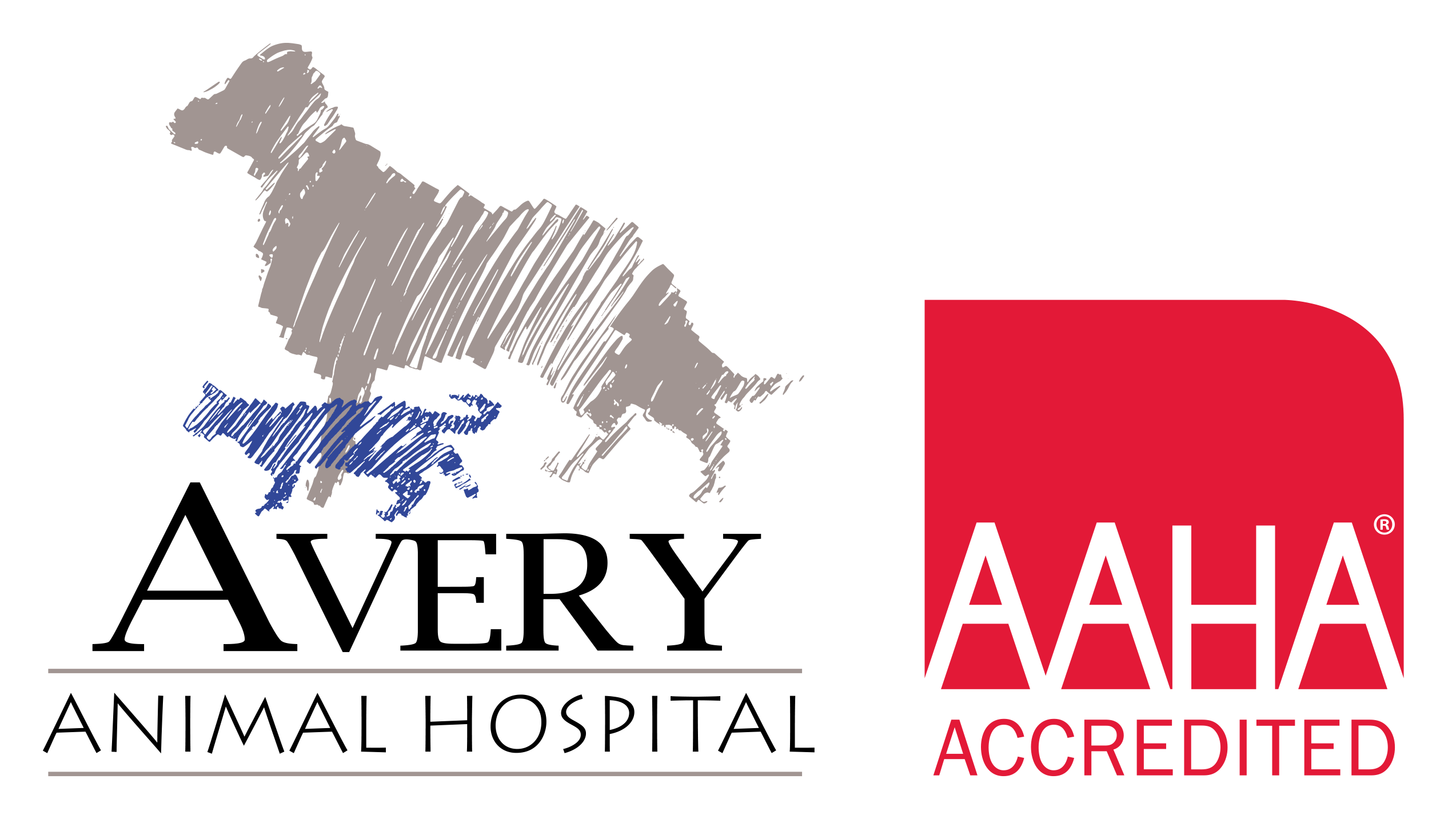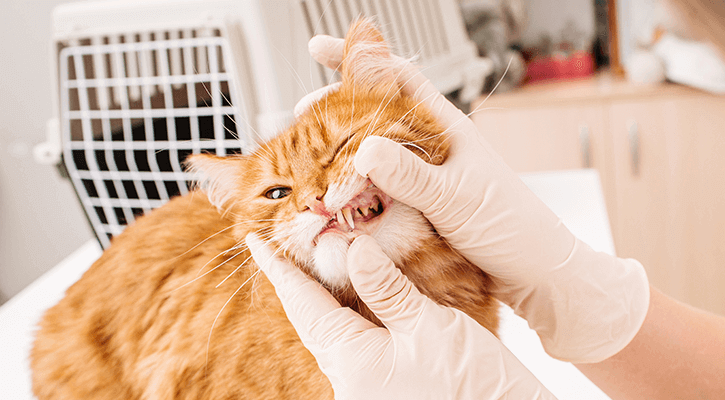
Dental Care
Dental disease affects an estimated 80% of dogs and 70% of cats by age three, and it is the most common illness seen in veterinary medicine today; unfortunately, it is also the most untreated disease. Poor oral hygiene can begin with bad “dog breath” or “cat breath” and lead to serious infection that enters your pet’s bloodstream and affects the kidneys, liver, lungs, and heart. Avery Animal Hospital believes dental health is an integral part of the overall well-being of your pet. Through educating our clients, we can improve the dental health of our patients.
Prevention is the best strategy in curbing this disease. An oral examination by the veterinarian should be performed at least once a year, and is included in your pet’s annual physical exam. In addition, home care is vital to the health of your pet. It is important to brush your pet’s teeth every day. Follow the instructions to learn how to establish this daily routine. In addition, there are several oral care products that can benefit your pet’s teeth besides brushing. Even with the most diligent home care, a professional pet teeth cleaning will be necessary at some point in your pet’s lifetime.
There are four stages of dental health and disease
Stage 1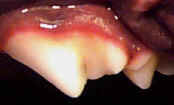 |
Stage 2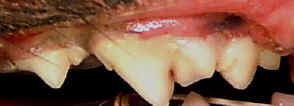 |
| These are healthy teeth and gums. There is minimal tartar on the surfaces of the teeth. Continued home care will help maintain this level of dental health. | Bad breath announces the presence of bacteria that accumulates along the gumline, where you can see inflammation. A professional dental cleaning is needed to remove the plaque and prevent it from hardening into tartar. |
Stage 3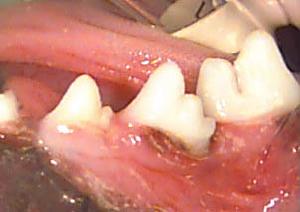 |
Stage 4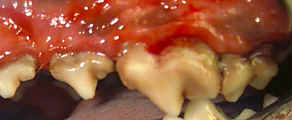 |
| Tartar encourages further bacterial growth, which can cause the gums to recede and pockets to develop. These pockets trap even more bacteria and the progressive infection weakens the tooth’s root structure. Bone loss begins. | Chronic infection is destroying the teeth, gums, and bone. Teeth that are loose most likely need to be extracted. |
Dental Procedure at Avery Animal Hospital
When your pet arrives the morning of the scheduled dental procedure:
- A brief physical examination is performed by a registered veterinary technician to assess vital signs.
- A pre-surgical blood work analysis is recommended. This will tell us if the liver, kidneys, blood count, etc., are within normal limits.
- Pre-medication is given to help reduce pain, calm your pet, and reduce the amount of gas anesthesia needed.
- An intravenous catheter is placed, a breathing tube is inserted, and a mix of gas anesthesia and oxygen is administered directly into the lungs.
- Monitoring equipment is attached to your pet throughout the procedure to monitor heart rate, respiratory rate, and oxygenation status. The technician monitors your pet’s anesthesia depth and vital signs. Based on the monitoring, anesthesia and intravenous fluids are adjusted accordingly.
The dental cleaning is performed by a registered veterinary technician and involves:
- Examination and assessment of the entire oral cavity and facial structures.
- Cleaning the surfaces of the teeth below the gum line, which is where sub-gingival plaque and calculus can cause dental disease.
- Cleaning the surfaces of the teeth above the gum line using mechanical and ultrasonic scaling instruments.
- Dental radiographs (X-rays) may be taken to further assess the health of the tooth roots and jaw bones and help determine disease progression.
- Assessment by the veterinarian of any problem areas. Tooth extraction is performed by the veterinarian if it is deemed necessary.
- Polishing, which smoothes the surface of the teeth and decreases the likelihood of future adhesion and plaque formation.
- Application of fluoride treatment to strengthen the teeth, decrease tooth sensitivity, and help retard future plaque activity.
- Application of Oravet plaque prevention gel, which helps slow plaque formation.
- Monitoring of the recovering patient, including giving additonal pain management as needed.
Here are some before and after pictures of a successful dental procedure at Avery Animal Hospital:
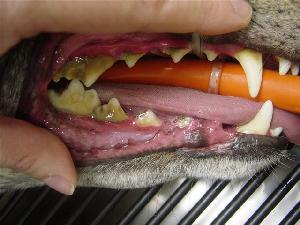 Right side of dog’s mouth(before) |
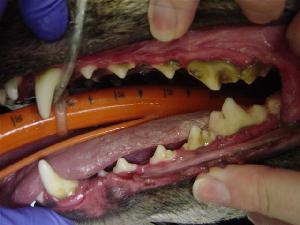 Left side of dog’s mouth(before) |
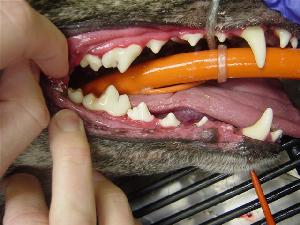 Right side of dog’s mouth(after) |
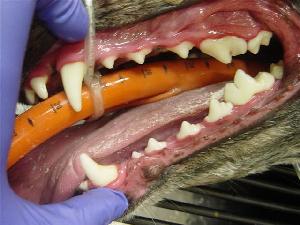 Left side of dog’s mouth(after) |
Brushing your pet’s teeth
We want your pet to be comfortable with you brushing and examining his/her mouth. The experience shouldn’t consist of simply restraining your pet and forcing teeth brushing, but rather teaching your pet to enjoy it. Ideally, you should begin familiarizing your pet with having his mouth handled from an early age, but your pet is never too old to start! Keep the sessions short and stay positive. Be sure to praise your dog or cat throughout the process.
- You should have your pet get used to putting things in his mouth. Put gravy, squeeze cheese, etc., on your finger and allow your pet to lick it off. Use a positive, calm voice as you speak to your pet. Rub your soaked finger gently over his gums and teeth. Once your pet is comfortable, you may proceed to the next step. Each step may only take several days, but don’t be discouraged if it takes up to a few weeks to a couple months.
- Once your pet is used to having your finger in his mouth, you can get him used to the texture of a toothbrush. Apply gravy, squeeze cheese, etc., on the toothbrush and allow him to lick it off.
- Now that your pet is used to the feel of the toothbrush’s bristles, you can put toothpaste on the toothbrush and allow him to lick it off. Use a toothpaste specifically for pets, preferably one containing enzymes that help break down plaque. Human toothpaste is not meant to be swallowed and has strong flavors that pets don’t normally like.
- Place your hand around your pet’s muzzle and allow him to lick some toothpaste off the toothbrush. Then brush a few of the front teeth.
- Place your hand around your pet’s muzzle and allow him to lick some toothpaste off the toothbrush. Then brush a few of the back teeth.
Important points to keep in mind:
- Use a small, soft-bristled brush or a piece of dry gauze wrapped around your finger. The rubber finger brushes are not abrasive enough for routine cleaning, but can be used initially to get you and your pet comfortable with the brushing process.
- Focus brushing the outer surfaces of the front and back teeth. Because their upper and lower teeth overlap, it is not always possible to brush the inside surfaces of the lower back teeth.
- You can teach your dog to hold a ball during brushing, which opens the mouth and exposes the lower back teeth. Do not try to pry or force open the mouth.
- If at any step your pet tries to run away or acts stressed, allow him a lick of toothpaste and then end your session. Start the next session on the step that your pet was most comfortable and repeat it many times until he is consistently relaxed before proceeding to the next step.
- Do not yell at or punish your pet for not holding still. Your pet should think of this as a fun, rewarding experience.
- Please discuss this process with us further if your pet has ever hissed, growled, or snapped at you. Your pet may need a slower protocol specifically designed for him.
Dental Care Products
While daily brushing is best, there are other dental hygiene products available. These are a few that we recommend.
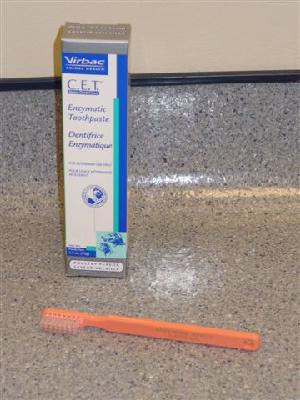 |
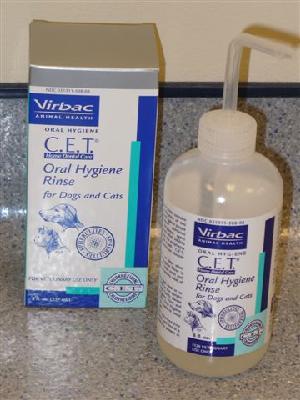 |
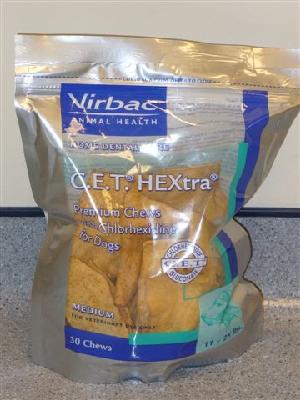 |
| Daily brushing with C.E.T. Toothpastes and C.E.T. Toothbrushes provides the very best in Home Dental Care for your pet. C.E.T. Toothpastes are specifically formulated to be safe, effective, and appealing to your dog or cat, and unlike “people” toothpastes, are meant to be swallowed. C.E.T. Toothbrushes are designed to reach all surfaces of your pet’s teeth and the soft bristles will not irritate your pet’s sensitive gums. | C.E.T. Oral Hygiene Rinse can provide effective plaque control without brushing. Simply insert the applicator tip into the area between the teeth and the cheek and apply. The rinse will spread throughout the oral cavity, coating the teeth with the anti-plaque chlorhexidine formulation and protecting against the accumulation of bacteria. |
These chews use the antibacterial activity of chlorhexidine and the mechanical action of chewing help to provide immediate surface plaque removal and tartar control. |
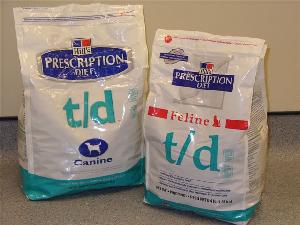 |
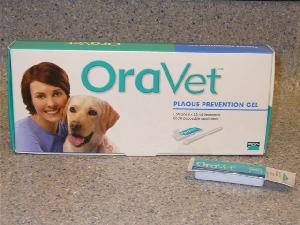 |
|
| There are foods specially formulated for pets with dental disesase, like Hill’s T/D. The kibble works like an edible toothbrush, scrubbing the visible tooth surface. | Oravet reduces plaque and tartar formation by creating an invisible barrier that prevents bacteria from attaching to your pet’s teeth. |
Dental Care for Your Pet Near You
If you want to schedule a teeth cleaning for your pet, contact us or Make An Appointment today!
Explore Our Complete List of Veterinary Services in Hilliard, OH
- Royal Canin Genetic Health Analysis
- Weight Management
- Ultrasound
- Puppy Preschool
- Puppy and Dog Care
- Parasite Prevention
- Pain Management
- Nutrition
- Medical Hospitalization
- Laser Therapy
- In-Hospital & Reference Laboratory Services
- Euthanasia Services
- Training
- Radiology
- Kitten and Cat Care
- Canine 101
- Behavior
- Vaccinations
- Pet Wellness Exams
- Senior Wellness
- Microchipping
- Surgery
